Behind the Scenes at Ashikaga Flower Park, Impressing the World: The "Touching Junction" Drives People and Business Performance by Konami Tsukamoto
CONTENTS
- First I was "the gardener's wife."
- Focus on jobs that protect and nurture greenery
- The instinct tells me that "this tree will move."
- You're a woman…
- From tree professional to botanical garden manager
- "Wow, it's beautiful! Nurturing People
- Creating a "unique" experience only in here
- What we can do because we are a public institution
There is an arborist who has successfully revived a botanical garden that had been suffering from slow growth in visitors and financial difficulties. She is Konami Tsukamoto, president of the Hamamatsu Flower Park. She became the first female arborist in Japan, and while gaining experience as a professional who listens to the voice of trees, an incident led her to participate in the management of the botanical garden. Since then, she has transformed the botanical garden, which had been continuously losing money, into "Japan's No. 1 flower park" with her "unconventional ideas" that are thoroughly attuned to the feelings of visitors. What is this unconventional approach to botanical garden management?
First I was "the gardener's wife."
It has been about eight years since I was involved in the management of Hamamatsu Flower Park. I am currently in the process of changing my mind. Hamamatsu Flower Park is a public botanical garden run by the Hamamatsu City Government, which means that it is an organization that strongly reflects the character of the government. What is important in administration is "not to challenge new projects," but how to digest the budget and events. It is not easy to change this mindset, but it is definitely starting to change.
The first botanical garden I was involved in managing was Ashikaga Flower Park. Unlike Hamamatsu Flower Park, it is a private botanical garden. No taxpayer money was invested in it. In the first few years after the park opened, the management was really difficult, and we had to go through two major restructurings. After overcoming these difficulties, the park is now the top flower park in Japan, attracting 1.5 million visitors a year.
Ashikaga Flower Park, followed by Hamamatsu Flower Park. I have been involved in the management of these two parks so far. However, I didn't do so because I love plants.
I am originally the wife of a gardener, and after I got married at the age of 22, I spent some time as a gardener's wife, working as a lady's maid. After more than ten years, my husband created a wonderful Japanese garden in Hamamatsu Castle Park. I was very proud of it and began to wonder how the garden would grow in the future. So I went directly to the city hall to ask, "Who will maintain and nurture that garden?
However, the city planning director said, "The government has its hands full with planting greenery and does not yet have the spirit to maintain and manage it. Then he said, "If you say so, why don't you start educating people at the private level?" he said. When I heard this, I thought to myself, "If that's the case, I'll do it myself!"
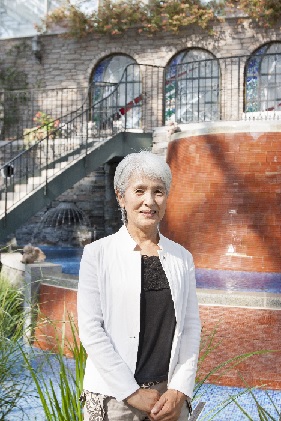
Konami Tsukamoto: Born in 1949 in Iwata City, Shizuoka Prefecture, she married a man who ran a landscaping business at the age of 22. In 1992, she became the first woman to be certified as an arborist. In 1993, she established a consulting company specializing in landscaping, greening, and tree protection. In 1996, she successfully transplanted a large wisteria at Ashikaga Flower Park, and in 1999, she became the park's director. In 2013, she became the chairman of the Hamamatsu Flower and Greenery Foundation, which operates the Hamamatsu Flower Park.
Focus on jobs that protect and nurture greenery
At that time, landscaping companies were completely male dominated. And every company was eager to receive orders for landscaping work. However, I thought that the work of maintaining the green spaces that had been created would be in the spotlight in the future, rather than creating them. This was right around the time when the job of building maintenance began to appear.
With my husband's permission, I launched a company called Green Maintenance at the age of 35, with the catchphrase, "Nurturing flowers and greenery with a woman's sensibility." In the beginning, I thought I could just manage lawns and take care of trees in a small way. However, we started to receive more and more greening jobs from residential and industrial parks. One client was adamant, "The people living in this complex of 300 lots are women, such as grandmothers and wives, so I want you to create something with a woman's sensibility."
A few years after launching Green Maintenance, I also established a landscape design office called the Environmental Greening Research Institute. This was also triggered by my doubts about the greening work at the time.
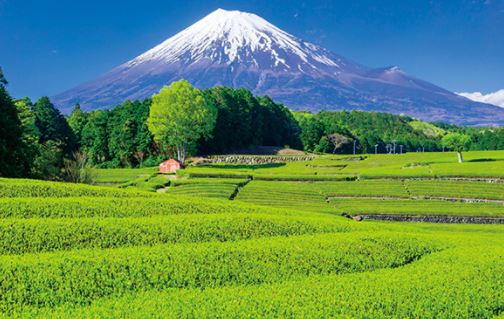
This was when I was involved in the greening of Hamamatsu City Hall. A famous general contractor received the order for this major project. We were involved in the construction as a subcontractor. At the meeting, the general contractor's designer suggested that we plant tea trees around the perimeter of the building because it was in Shizuoka (known for its good tea leaves). But I argued against it, saying, "No, not tea trees. Tea trees have an insect called the "tea poison moth," which spreads inflammation all over the body just by touching it. If tea trees are planted in a place where many people gather, such as city hall, even small children will be exposed to the risk of tea poison moths. Besides, the trees need to be trimmed three or four times a year to maintain the beautiful scenery. When I tell people that they shouldn't plant something that takes so much time and effort, they look at me with disapproval.
People who have no knowledge of plants design greenery based on appearance alone. If that's the case, I should create a landscape design office. That's what I thought, and that's when I started the Environmental Greening Research Institute. Since then, we have undertaken many large-scale landscaping projects, including the rooftop garden of a 45-story building and the gardens of hotels and wedding halls.
The instinct tells me that "this tree will move."
I am known as the "first female arborist". However, I had no intention of becoming an arborist. I just happened to take and pass the arborist certification exam that was created in 1991. The truth is that I was the only woman to take the exam.
As the first female arborist, I began to work on landscaping projects that were easy to care for, did not require much maintenance, and would enhance the image of the client.
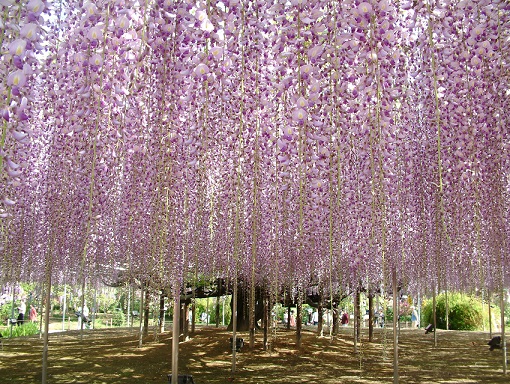
In 1994, while I was still doing this kind of work, I was offered a job that would be a turning point for me. It was a request from the owner of Ashikaga Flower Park. I was not a great arborist, but thanks to my title as the first female arborist, I was featured in various media. One day, I saw an article in a national newspaper that said, "Konami Tsukamoto, the first female arborist, has moved more than a hundred giant trees and hasn't lost a single one," and the owner said, "There's a big wisteria at our farm, and I have been looking for four years for someone to transplant the wisteria for the opening of the park, but I can't find anyone who will do it, so I am in trouble.
Our employees were very much against taking on this job. However, my curiosity and my inability to say no to a request prevailed, and I decided to go and see the wisteria. The moment I saw the wisteria, I was convinced that the tree would move. It moves, which means it has the strength to withstand transplantation. Like humans, we cannot perform a major surgery when we are not in good health. But if you are healthy, you can endure. The wisteria was full of energy and vitality. So I said, "I can transplant it. I just need to figure out how to do it."
You're a woman…
There was a reason why the employees were against the transplant. The wisteria was a large tree with a diameter of one meter. However, the literature said that wisteria transplants should be limited to 60 cm in diameter. This is also the reason why Ashikaga Flower Park was rejected by various experts for transplanting. However, that document was written in the Meiji era more than 150 years ago. I decided that with today's technology, even a wisteria one meter in diameter would be manageable.

The transplanting of the wisteria was jointly undertaken by the local Ashikaga Landscaping Association. As an arborist, I would participate in the transplanting. However, the world of landscaping is still a male-dominated society, and the craftsmen were all veterans in their fifties and sixties. I could clearly see that they had a "you're a woman" attitude toward me.
You're a woman. These words were thrown at me even after I became quite famous as an arborist. But you can't do a transplant unless you get the craftsmen to listen to you. I gathered the craftsmen together and said, "I'm going to explain my way of doing things, and if you think differently, please give me your opinion. But in the end, you will have to follow the conclusion I have reached. Please make that promise here and now. If you don't promise me that, I won't accept this job. He said, "If you succeed, it will be thanks to you. If it fails, it will be my responsibility.
The transplant will be successful if the craftsmen are good. No matter how much I tell them to do it this way, the craftsmen will work based on their own experience. It is their craftsmanship that makes the transplant a success. That's why I always thanked my employees and craftsmen by saying. It's me, with the title of arborist, who gets all the press attention. But it's thanks to you that my work is going well. I'm sorry that I'm always the only one in the limelight, but the success of this job is thanks to all of you. Thank you so much.
From tree professional to botanical garden manager
The members of the Ashikaga Landscaping Association gladly accepted my request. Two years after the request, the wisteria transplant was a success.
It is normal for an arborist who successfully transplants wisteria to receive a letter of appreciation from the client and leave. However, I was asked by the owner to design the garden as well. At first, the owner only thought of me as an arborist, but then he found out that I also designed trees, and he entrusted me with the design of the garden. In 1997, Ashikaga Flower Park was opened.
However, after a year or two, it became apparent that the park was not doing well. I felt that I, as the designer of the park, was responsible for the poor management, so I decided to invest in the park and join the management team.
Ashikaga Flower Park is a botanical garden where wisteria plays a leading role. I designed the park with wisteria in mind. However, wisteria grows at a pace of one full year. Therefore, when the park first opened, it was not large enough to impress the visitors. It wasn't until around 1999, when I became the director of the flower park, that the wisteria finally took on a wonderful appearance.
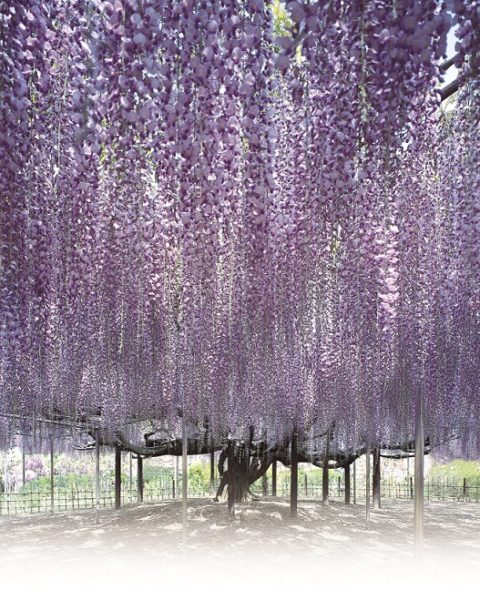
Before I became the director of the garden, I walked around all over Japan looking at wisteria. You can't do business without knowing the level of other wisteria. In short, I researched my competitors. As a result, I came to the conclusion that the wisteria at Ashikaga Flower Park is the most beautiful in the world.
There was one more thing I noticed. Another thing I noticed is that there is a concentration of wisteria viewing spots in neighboring Saitama Prefecture. Ushishima, Koshigaya, and other natural monument wisteria are everywhere. Moreover, there are seven million people in the prefecture. I thought, "If I work here, the customers will surely come.
The fact that there are many wisteria that are national treasures means that the people of Saitama Prefecture are familiar with wisteria. So, I thought of distributing fliers that read "Ashikaga Flower Park: The World's Greatest Wisteria Garden" to famous wisteria spots in Saitama Prefecture. I did this because I thought that the people of the prefecture who are proud of their wisteria would surely come to Ashikaga Flower Park to see if the wisteria there is really the best in the world. It takes about an hour by car from Saitama Prefecture to Ashikaga City in Tochigi Prefecture. It's far enough to make a day trip.
The plan was a success. People from other prefectures started coming to the park one after another.
"Wow, it's beautiful! Nurturing People
Another thing I did to rebuild the business was to change the fees. The park had originally adopted a variable fee of 300 to 700 yen, but I raised it to 1,000 yen. I raised the fee to 1,000 yen. On the other hand, I waived the entrance fee in the winter when the flowers were not in bloom. This immediately doubled the sales. The free admission brought more customers into the park and increased the use of the restaurants and stores.
We also held early morning meetings with managers and tried various human resource development measures, such as giving lectures on trees to the staff while they worked together. But in the end, it wasn't these things that changed the staff. It was the customers who came to the park that changed the mindset of the staff.
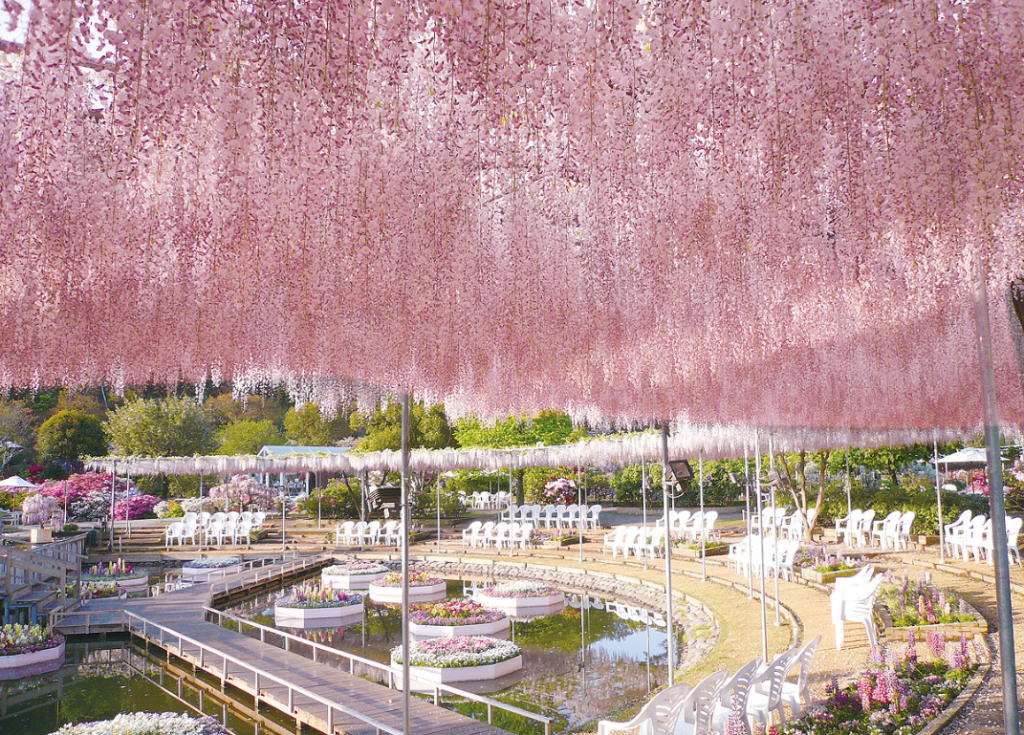
When visitors saw the wisteria at Ashikaga Flower Park, they would exclaim, "Wow, it's beautiful! When they see the wisteria at Ashikaga Flower Park, they shout with joy. This is the best praise for the staff. After all, seeing the wisteria that we have taken such pains to manage, we are moved to tears and shake our bodies. There is no greater reward than this. The sight of customers being moved motivates the staff to "work even harder" and grow more and more.
Here is an example. A customer who came to see the wisteria said, "I am lucky to be alive. I was able to see such beautiful wisteria." The visitor was from Minamisoma in Fukushima Prefecture. I told this story to my staff. This kind of customer feedback gives the staff a sense of fulfillment that they are contributing to society and gives them the status of working at Ashikaga Flower Park.
Creating a "unique" experience only in here
The number of visitors to the park, which was less than 200,000 when it first opened, increased year by year to 340,000, 470,000, and 550,000. In the midst of all this, I was asked to become the chairman of the board of directors of Hamamatsu Flower Park.
At first, I had no intention of doing it at all. I was running two companies in addition to being the director of Ashikaga Flower Park, and I thought I wouldn't be able to handle it. No matter how many high-ranking people came to see me, I kept refusing.
In the meantime, the director of Hamamatsu Flower Park himself came to visit me. He said, "The mayor has promised that if we don't make the park profitable in the next three years, it will become just a park. If that happens, more than a hundred employees will be fired. I need your help," he said to me. It is my nature not to say "no" to a request from someone in a weak position. In 2001, I became the president of Hamamatsu Flower Park.
Until a while ago, the park was profitable. The number of visitors to the park had reached 550,000, which was more than the profit break-even point of 450,000. However, since the construction of Hamanako Garden Park nearby on the shores of Lake Hamanako, which is free to enter, the number of visitors has plummeted to 250,000.
The staff used to say, "The Garden Park is the reason why the number of visitors decreased. The first thing I did was to stop complaining that it was the Garden Park's fault. The Garden Park is already there, and we can't get rid of it. "Don't tell us what we can't control."
With or without the Garden Park, let's make this park an attractive place. That's why we introduced the variable entrance fee system. Until then, the entrance fee to the park was 800 yen for the entire year. Now, it is free during the summer. In the Garden Park, there is a place where you can splash around in the water, and it's free. But if the Flower Park charges 800 yen, there is no way they will attract visitors.
What I put more effort into than anything else was to create something that was unique and could not be beaten anywhere else. Once I asked the staff, "What is the highlight of this garden? Various flowers were mentioned, including cherry blossoms, roses, tulips, and hydrangeas. I said, "That's amazing. You have everything. But "having everything is the same as having nothing," I said. If there is nothing else! If there is no such thing as "the only thing," then there is no way to survive. So I asked again, "What's the only thing here? I asked again. The answer came back, "Cherry blossoms and tulips.
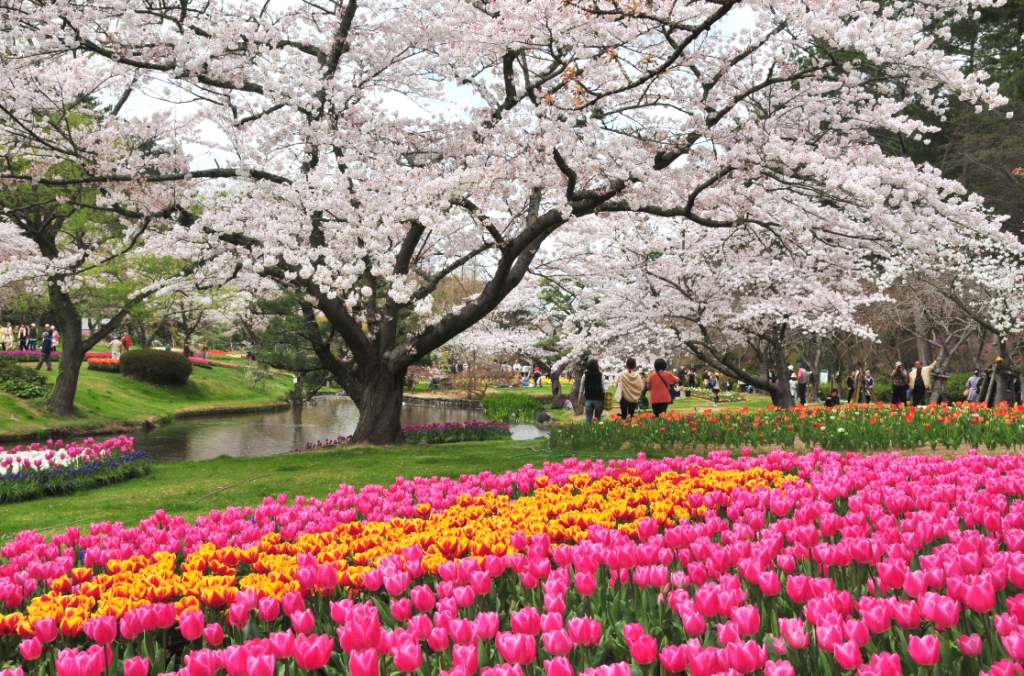
One of the world's most famous places for tulips is Keukenhof Park in the Netherlands. Here, there are tulips, but only a few cherry trees. On the other hand, Hamamatsu Flower Park has hundreds of thousands of tulips and 1,300 cherry trees. We decided to make the combination of cherry blossoms and tulips the main attraction. That's what I decided and started working on creating the most beautiful cherry blossom and tulip garden in the world. The number of visitors to the park has increased dramatically from 250,000 a year before to 770,000 last year.
If you want to attract visitors, it's not enough to have the most beautiful flowers. It has to be "overwhelmingly beautiful." Just as there is a break-even point in management, I believe there is a break-even point in people's hearts. This is the point at which you are moved to tears if you exceed it. If you are truly moved, you will want to tell others about it, and you will be more inclined to come back. I believe that the emotional breaking point is the point that drives people and business performance. However, in order to exceed the emotional breaking point, it must be "overwhelming".
What we can do because we are a public institution
At Hamamatsu Flower Park, we are now gradually accepting young people who have stopped going to school or have withdrawn. They plant flower seeds, water them when they sprout, and replant them in the flower beds when they grow up. I want them to hear the joyful voices of visitors who see them and say, "They are beautiful.
At Ashikaga Flower Park, I have seen an example of a depressed young man who successfully recovered from his depression by interacting with plants. I believe that plants have the power to restore humanity and I believe that using this power to restore people's minds is what public botanical gardens should be doing. In Japan, there are more than 100 national and public botanical gardens. If all of them were to work on restoring humanity, many more people would be saved, and the existence of public botanical gardens would become more meaningful.
Through plants, we can help those who have been left behind in society to live a richer life. This is what I want to do the most right now.


